Ninoy Aquino International Airport Terminal 1
Ninoy Aquino International Airport Terminal 1 (NAIA 1; also known as Ninoy Aquino Terminal) is an airport terminal at Ninoy Aquino International Airport (NAIA) in Paranaque City, Metro Manila, Philippines. NAIA is the main airport serving Manila and its surrounding metropolitan area. Located along the border between the cities of Pasay and Parañaque and opened in 1981, NAIA 1 has an area of 67,000 square metres (720,000 sq ft) and is the first higher-capacity airport terminal in the Philippines and the second oldest-terminal in the NAIA complex after Terminal 4, or the Manila Domestic Passenger Terminal.

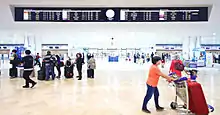
The terminal originally had a design capacity of 4.5 million passengers per year,[1] but it was further expanded to accommodate 6 million passengers.[2] Terminal 1 is currently used by numerous major international airlines, including Philippine Airlines, China Airlines, China Southern Airlines, Malaysia Airlines, Vietnam Airlines, Japan Airlines, Korean Air, Royal Brunei Airlines, and Saudia.[3][4]
History
Early years
After the original structure of Manila International Airport was destroyed by a fire on January 22, 1972, a slightly smaller terminal, designed by Philippine National Artist for Architecture, Leandro Locsin, Sr. and his firm L.V. Locsin and Associates, was built to replace it. This airport terminal would serve as the main terminal of Manila International Airport from that year until 1981.
Conception
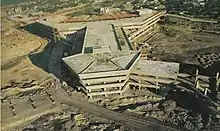
The development of the Manila International Airport was approved through the promulgation of Executive Order No. 381. In 1973, a feasibility study and airport master plan were completed by Airways Engineering Corporation through a US$29.6 million loan from the Asian Development Bank.[5] The Detailed Engineering Design of the New Manila International Airport Development Project was done by Renardet-Sauti, Transplan, and F. F. Cruz Consultant while the terminal's Detailed Brutalist Architectural Design was prepared by Leandro Locsin's L.V. Locsin and Associates.[6]
In 1974, the detailed designs were adopted by the Philippine Government. The designs were subsequently approved by the Asian Development Bank on September 18, 1975. The government chose an area close to the original site of the former Manila Airport, deciding on an area of land governed by Parañaque City, which was at the time a municipality of Metro Manila. Actual work on the terminal began during the second quarter of 1978.
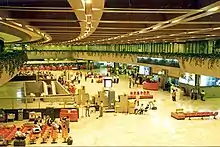
Opening
The terminal was completed in 1981 and began operations in 1982. On April 2, 1982, a PAL Boeing 747-200B arriving from San Francisco via Honolulu became the first aircraft to dock at the terminal. During its opening, NAIA Terminal 1 was viewed as one of the world's most modern airports.
Assassination of Benigno Aquino
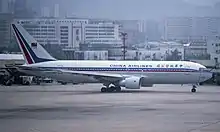
China Airlines Flight 811 was a regularly scheduled flight from Taipei to Manila. On August 21, 1983, the flight utilized a Boeing 767-200 with the registration B-1836. On board this flight was Filipino politician Benigno S. Aquino, Jr., known by the nickname, Ninoy, who used a forged passport with the name "Marcial Bonifacio" for the final leg of his trip to the Philippines to avoid identification. Upon landing in Manila, the aircraft docked at Gate 8 (present-day Gate 11). Aviation Security Command (AVSECOM) personnel escorted Aquino out of the plane to the tarmac where a van owned by the agency awaited him. A single gunshot was heard, which was then identified as the shot that killed Aquino. Several shots burst out, killing the alleged assassin, Rolando Galman. Seconds later, a barrage of gunfire erupted, causing chaos in the plane, the tarmac, and the terminal. The bodies of Aquino and Galman lay on the tarmac; Aquino's body was loaded onto the van, which then sped away.
Ironically, Flight 811 was the same flight number that had been involved in an accident in 1980 at the same airport, albeit with a different aircraft used (a Boeing 707). Four years after Aquino's assassination in 1983, the airport was given its present name by virtue of Republic Act No. 6639.
Presently, a body mark of Aquino's assassination is on display at the departure parking lot. The spot at Gate 8 where he was killed has a memorial plaque.
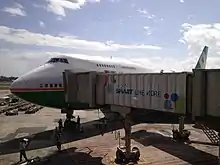
Capacity breach
In 1989, a Master Plan Review recommended the construction of two new terminals (NAIA 2 and NAIA 3), as well as many other facility improvements.[6]
In 1991, the terminal reached capacity when it registered a total passenger volume of 4.53 million. Since 1991, the terminal has been over capacity and has been recording an annual average growth rate of 11%,[6] but improvements to the airport increased its capacity to 6 million passengers yearly.[2]
The terminal today
The terminal currently serves foreign carriers operating in Manila, except for All Nippon Airways, Cathay Pacific, Delta Air Lines, Emirates, KLM, Qantas, Qatar Airways, Singapore Airlines, Turkish Airlines, and United Airlines, which uses Terminal 3. It also serves Philippine Airlines flights to and from Toronto, Vancouver, New York, Auckland, Phnom Penh, Hanoi and the Middle East, except Dubai flights.[7][8]
Reception and renovation
Compared to international terminals in other Asian countries, NAIA 1 has been consistently ranked at the bottom due to limited and outdated facilities, poor passenger comfort, and crowding due to operating above designed capacity.[9] From 2011 to 2013, NAIA 1 was ranked first on the lists of Asia's worst and the world's worst airports by the travel website "The Guide to Sleeping In Airports".[10]
Transport authorities planned to give NAIA 1 a makeover; the plans were approved by President Benigno Aquino III. The makeover and upgrade includes the expansion of the arrival area, the addition of parking spaces, and the improvement of other terminal facilities.[11] The Transportation and Communications Department previously announced that as soon as Terminal 3 becomes fully operational, NAIA 1 was eyed by Cebu Pacific with the intention rehabilitating the terminal into an "Airport City" and serve as an exclusive terminal for their aircraft.[12]
On January 23, 2014, NAIA 1 started the process of upgrading and modernizing the 32-year-old passenger terminal building, planned to be finalized and operational by May 2015.[13][14] The renovation project was divided into six phases and had 40 percent completion on December 16, 2014.[15] The project included the installation of buckling restrained braces to strengthen the structural integrity of the building, as well as a facelift in the interior design of the terminal.[16] From August 1 to October 1, 2014, five international airlines—Delta Air Lines, KLM, Emirates, Singapore Airlines, and Cathay Pacific—were transferred to Terminal 3 in an effort to decrease the congestion of the terminal.[17] On October 28, 2018, United Airlines and Qantas were also relocated to Terminal 3.[18] Qatar Airways was also relocated to Terminal 3 on December 1, 2018, while Turkish Airlines was transferred to Terminal 3 on January 1, 2019.[19]
Operations
NAIA 1 is the terminal of foreign airlines including Philippine Airlines, China Airlines, China Southern Airlines, Malaysia Airlines, Vietnam Airlines, Japan Airlines, Korean Air, Royal Brunei Airlines, Saudia, and Etihad Airways.[3][4] It is also the terminal of Philippine Airlines for international flights: the ASEAN (Phnom Penh and Hanoi), New Zealand (Auckland), the USA (New York City and Seattle), Canada (Toronto and Vancouver), and the Middle East (Dammam, Doha, and Riyadh).
Airlines and destinations
References
- TERMINAL 1 Archived October 14, 2007, at the Wayback Machine
- "About NAIA Terminal 1". 125.60.203.88. Archived from the original on 2013-02-10. Retrieved 2018-11-30.
- "NAIA Terminal 1". www.manila-airport.net. Retrieved 2019-07-09.
- "Manila Airport - NAIA (MNL): Airlines". www.manila-airport.net. Retrieved 2019-07-09.
- "LN0164-PHI: Manila International Airport Development". Asian Development Bank. Retrieved August 25, 2014.
- Airport : Terminal 1 Manila International Airport Authority Archived April 14, 2006, at the Wayback Machine Accessed September 7, 2006
- "Several PAL Mid-East flights to transfer to T1". Philippine Airlines. June 27, 2017. Retrieved July 9, 2017.
- https://www.philippineairlines.com/TravelInformation/BeforeYouFly/AtTheAirport/KnowYourTerminal/PALInternationalAirports
- Reviews of Manila Ninoy Aquino Airport with Passenger reviews about Manila Ninoy Aquino Airport standards airlinequality.com.
- Santos, Rudy (October 19, 2017). "NAIA no longer on worst airports list". The Philippine Star. Retrieved December 20, 2017.
- "PNoy okays P1.16B budget for NAIA-1 facelift". ABS-CBN News. January 2, 2012. Retrieved December 20, 2014.
- "Cebu Pacific eyeing 'Airport City'--DoTC". Philippine Daily Inquirer. November 11, 2007. Retrieved October 23, 2014.
- "NAIA-1 rehab underway". The Philippine Star. January 24, 2014. Archived from the original on August 11, 2014. Retrieved July 29, 2014.
- "NAIA Terminal 1 fully rehabilitated and operational by May 2015 - Abaya". InterAksyon.com. December 17, 2014. Archived from the original on December 20, 2014. Retrieved December 20, 2014.
- "Naia 1 rehabilitation 40% complete–Abaya". BusinessMirror. December 16, 2014. Retrieved December 20, 2014.
- "Steel braces to make Naia quake-resistant". Philippine Daily Inquirer. August 27, 2014. Retrieved August 27, 2014.
- "Major foreign airlines move to NAIA-3 next week". GMA News. GMA News and Public Affairs. July 24, 2014. Retrieved July 31, 2014.
- http://philippineairspace.blogspot.com/2018/10/naia-terminal-rationalization-takes.html
- "2 international airlines to move flights to NAIA Terminal 3". ABS-CBN News. October 27, 2018. Retrieved October 29, 2018.
- "Philippine Airlines adds Seattle service from May 2020". Retrieved 5 January 2020.